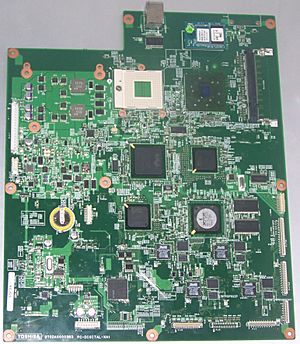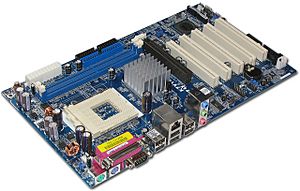Computer engineering facts for kids
Computer engineering is a discipline that integrates several fields of electrical engineering and computer science required to develop computer hardware and software. Computer engineers usually have training in electronic engineering (or electrical engineering), software design, and hardware-software integration instead of only software engineering or electronic engineering. Computer engineers are involved in many hardware and software aspects of computing, from the design of individual microcontrollers, microprocessors, personal computers, and supercomputers, to circuit design. This field of engineering not only focuses on how computer systems themselves work, but also how they integrate into the larger picture.
Usual tasks involving computer engineers include writing software and firmware for embedded microcontrollers, designing VLSI chips, designing analog sensors, designing mixed signal circuit boards, and designing operating systems. Computer engineers are also suited for robotics research, which relies heavily on using digital systems to control and monitor electrical systems like motors, communications, and sensors.
In many institutions, computer engineering students are allowed to choose areas of in-depth study in their junior and senior year, because the full breadth of knowledge used in the design and application of computers is beyond the scope of an undergraduate degree. Other institutions may require engineering students to complete one or two years of General Engineering before declaring computer engineering as their primary focus.
Contents
- History
- Work
- Specialty areas
- Coding, cryptography, and information protection
- Communications and wireless networks
- Compilers and operating systems
- Computational science and engineering
- Computer networks, mobile computing, and distributed systems
- Computer systems: architecture, parallel processing, and dependability
- Computer vision and robotics
- Embedded systems
- Integrated circuits, VLSI design, testing and CAD
- Signal, image and speech processing
- Education
- Similar occupations and fields
- Images for kids
- See also
History
The first computer engineering degree program in the United States was established in 1972 at Case Western Reserve University in Cleveland, Ohio. As of 2015[update], there were 238 ABET-accredited computer engineering programs in the US. In Europe, accreditation of computer engineering schools is done by a variety of agencies part of the EQANIE network. Due to increasing job requirements for engineers who can concurrently design hardware, software, firmware, and manage all forms of computer systems used in industry, some tertiary institutions around the world offer a bachelor's degree generally called computer engineering. Both computer engineering and electronic engineering programs include analog and digital circuit design in their curriculum. As with most engineering disciplines, having a sound knowledge of mathematics and science is necessary for computer engineers.
Work
There are two major specialties in computer engineering: hardware and software.
Computer hardware engineering
Most computer hardware engineers research, develop, design, and test various computer equipment. This can range from circuit boards and microprocessors to routers. Some update existing computer equipment to be more efficient and work with newer software. Most computer hardware engineers work in research laboratories and high-tech manufacturing firms. Some also work for the federal government. According to BLS, 95% of computer hardware engineers work in metropolitan areas. They generally work full-time. Approximately 33% of their work requires more than 40 hours a week. The median salary for employed qualified computer hardware engineers (2012) was $100,920 per year or $48.52 per hour. Computer hardware engineers held 83,300 jobs in 2012 in the USA.
Computer software engineering
Computer software engineers develop, design, and test software. They construct, and maintain computer programs, as well as set up networks such as "intranets" for companies. Software engineers can also design or code new applications to meet the needs of a business or individual. Some software engineers work independently as freelancers and sell their software products/applications to an enterprise or individual.
Specialty areas
There are many specialty areas in the field of computer engineering.
Coding, cryptography, and information protection
Computer engineers work in coding, cryptography, and information protection to develop new methods for protecting various information, such as digital images and music, fragmentation, copyright infringement and other forms of tampering. Examples include work on wireless communications, multi-antenna systems, optical transmission, and digital watermarking.
Communications and wireless networks
Those focusing on communications and wireless networks, work advancements in telecommunications systems and networks (especially wireless networks), modulation and error-control coding, and information theory. High-speed network design, interference suppression and modulation, design and analysis of fault-tolerant system, and storage and transmission schemes are all a part of this specialty.
Compilers and operating systems
This specialty focuses on compilers and operating systems design and development. Engineers in this field develop new operating system architecture, program analysis techniques, and new techniques to assure quality. Examples of work in this field includes post-link-time code transformation algorithm development and new operating system development.
Computational science and engineering
Computational Science and Engineering is a relatively new discipline. According to the Sloan Career Cornerstone Center, individuals working in this area, "computational methods are applied to formulate and solve complex mathematical problems in engineering and the physical and the social sciences. Examples include aircraft design, the plasma processing of nanometer features on semiconductor wafers, VLSI circuit design, radar detection systems, ion transport through biological channels, and much more".
Computer networks, mobile computing, and distributed systems
In this specialty, engineers build integrated environments for computing, communications, and information access. Examples include shared-channel wireless networks, adaptive resource management in various systems, and improving the quality of service in mobile and ATM environments. Some other examples include work on wireless network systems and fast Ethernet cluster wired systems.
Computer systems: architecture, parallel processing, and dependability
Engineers working in computer systems work on research projects that allow for reliable, secure, and high-performance computer systems. Projects such as designing processors for multi-threading and parallel processing are included in this field. Other examples of work in this field include development of new theories, algorithms, and other tools that add performance to computer systems.
Computer vision and robotics
In this specialty, computer engineers focus on developing visual sensing technology to sense an environment, representation of an environment, and manipulation of the environment. The gathered three-dimensional information is then implemented to perform a variety of tasks. These include, improved human modeling, image communication, and human-computer interfaces, as well as devices such as special-purpose cameras with versatile vision sensors.
Embedded systems
Individuals working in this area design technology for enhancing the speed, reliability, and performance of systems. Embedded systems are found in many devices from a small FM radio to the space shuttle. According to the Sloan Cornerstone Career Center, ongoing developments in embedded systems include "automated vehicles and equipment to conduct search and rescue, automated transportation systems, and human-robot coordination to repair equipment in space."
Integrated circuits, VLSI design, testing and CAD
This specialty of computer engineering requires adequate knowledge of electronics and electrical systems. Engineers working in this area work on enhancing the speed, reliability, and energy efficiency of next-generation very-large-scale integrated (VLSI) circuits and microsystems. An example of this specialty is work done on reducing the power consumption of VLSI algorithms and architecture.
Signal, image and speech processing
Computer engineers in this area develop improvements in human–computer interaction, including speech recognition and synthesis, medical and scientific imaging, or communications systems. Other work in this area includes computer vision development such as recognition of human facial features.
Education
Most entry-level computer engineering jobs require at least a bachelor's degree in computer engineering. Sometimes a degree in electronic engineering is accepted, due to the similarity of the two fields. Because hardware engineers commonly work with computer software systems, a background in computer programming usually is needed. According to BLS, "a computer engineering major is similar to electrical engineering but with some computer science courses added to the curriculum". Some large firms or specialized jobs require a master's degree.
It is also important for computer engineers to keep up with rapid advances in technology. Therefore, many continue learning throughout their careers. This can be helpful, especially when it comes to learning new skills or improving existing ones. For example, as the relative cost of fixing a bug increases the further along it is in the software development cycle, there can be greater cost savings attributed to developing and testing for quality code as soon as possible in the process, and particularly before release.
Similar occupations and fields
- Computer programming
- Electrical engineering
- Software development
- Systems analyst
Computers are electrical machines that run programs. So Computer engineering has parts of both electrical engineering and computer science/software engineering. In Computer engineering classes, students learn about the hardware and software of computers. This starts with learning how transistors and computer chips are made and how they work (which uses quantum mechanics). Then the student learns how the chips talk to each other and how to make a complete printed circuit board (PCB). This is the electrical part. They also learn how to program the ROM or Flash memory so the computer can do something useful.
Because Computer engineering is closely related to electrical engineering and computer science, the fields are found in the same department at many universities. Students also need to learn fundamental science subjects and mathematics, such as calculus and differential equations.
Computer engineering is difficult to learn, but computer engineers are needed. Software engineering companies, telecommunications firms, designers of digital hardware, and many other companies hire computer engineering majors right out of college and pay them well.
Images for kids
-
ENIAC, the first electronic computer.
-
Source code written in the C programming language.
-
Windows 10, an example of an operating system.
-
An example of a humanoid robot.
See also
 In Spanish: Ingeniería en computadores para niños
In Spanish: Ingeniería en computadores para niños










